Hi there
I've come by one of the old dbx 160x units. However, it gives an unacceptable buzz when I crank the output gain above 0. It loses the buzz when I bypass the unit or turn it back down. Could this be a grounding issue?
Other important stuff is:
- I live in the UK and but my unit has a 115v power supply and has a US 'Type A' two prong plug on it. Therefore, I use a UK to US step down converter on it.
- I've used everything in the signal chain plugged into the the same power strip and have also moved the dbx unit out of the room away from other stuff which could potentially cause EMI. I've also tried a different outlet too. I've had no success with any of my attempts.
- Signal chain = Jazz Bass>>>Neve 5016>>>dbx 160x>>>RME MultifaceII.
If this is a grounding issue, is it to do with having no ground in the plug relative to my other gear? Apologies if this is a silly suggestion as I'm not an expert in electrics.
From what I can gather from the dbx 160x manual, they suggest that if hum persists then the sheild should be disconnected from the source (i.e. in my case at the XLR female end coming from my preamp's output). They also suggest doing the same from at the end of the cable going into my interface's input, leaving the sheild connected at the dbx 160x's output.
Is this what's being suggested here or am I misinterpreting the information? Also, is this safe? Here's a snippet from the manual:
Any advice would be greatly appreciated. It's driving me daft.
Regards
LiD
Topic Tags
Comments
Hi Thank you so much for your help dvdhawk. I really appreciate
Hi
Thank you so much for your help dvdhawk. I really appreciate it.
You are absolutely correct, my 160x is switchable. The seller said it a was a US voltage model and I just took this to be the case. I took the little plate off and low and behold, there's a switch. This means I can now put a UK plug on the cable, or just use the 'US type A/B' travel adapter I have (not the step down one).
I wonder if changing the voltage may help? I won't know until tomorrow though as I'm swamped with visitors just now and just have this spare 5 minutes to write this reply.
Regarding the barrier strip on the back of the 160x. I'm not familiar with this. What is its purpose? I know the TRS signal goes in via the 1/4 input so I'm confused as to what part the barrier strip plays?
Does tightening/untightening the screws on the barrier strip connect/disconnect the T, R and S of a signal plugged in via the 1/4 input/output?
Thank you for this.
LiD
Here's a note I saw in the manual that will be of interest when
Here's a note I saw in the manual that will be of interest when you're putting on the UK plug.
If you're using the TRS, you don't need to worry about the terminal strip. The terminals are just tied together with the respective TRS contacts. Some people prefer the terminal strips for permament installations.
You might want to check to make sure the factory jumpers for the Detection Circuitry are still where they are supposed to be. [A]
Good luck.
Thank you dvdhawk Forgot to mention, the type A plug was non po
Thank you dvdhawk
Forgot to mention, the type A plug was non polar (equal sized prongs). I'll try both ways to see what happens.
Next I'm going to try the voltage switch. If this doesn't work then I'll then try and disconnect the shield from cable end at the 160x's output and also (if need be) from the the output of my Portico pre. I suppose another way to do this would be to use something along the lines of [[url=http://[/URL]="http://www.thomann…"]this thing[/]="http://www.thomann…"]this thing[/]. Probably a handy thing to have around.
Is there anything electrically unsafe in modding cables - i.e. chopping off the ground (shield) wire at one end, given that the 160x has a two prong (Neutral and Live) power cable without an Earth? Or is my lack of electrical knowledge getting me paranoid?
Also, should a disconnected shield just be left in the cable unconnected to anything?
I'll post and let you know how I get on tomorrow. You've been very helpful and I've enjoyed researching and learning about this stuff. I'm getting tempted to make my own cables now. One thing at a time though. :wink:
LiD
It is completely safe to disconnect the shield from an audio cab
It is completely safe to disconnect the shield from an audio cable. This is completely different from removing the electrical earth ground (which is never recommended).
You only disconnect the shield at one end of the cable, and as you say the old dbx doesn't have an earth ground anyway. That is why I suggested disconnecting the shield from the dbx end rather than your other equipment. If you were using the terminal strip it would be very easy to experiment.
Thanks dvdhawk I've been messing around a little over the weeke
Thanks dvdhawk
I've been messing around a little over the weekend and have compared the 160x to a 166 and an RNC. They all seem to have the same buzzing noise when their output gain is cranked between 10-20. It's even a bit audible as you move between 0-10. I'm not sure if I'm just turning up the noise floor or not. However, the severity of the noise does not give me this impression.
I'm now going to do some gain staging experimentation and use the units different distances from my Dell monitor etc just in case there's EMI at play. The two dbx units and the RNC do not contain earth wires in their power flexes. This would not be an issue would it? Incidentally, why is there an omission of an earth wire in some country's plugs?
I'm also going to use different preamps next weekend too in order to get a sense of which setup(s) are causing (or not causing) stuff.
Thanks for your help dvdhawk. I really appreciate it. Will update next week.
Regards
LiD
hueseph wrote: The Jazz Bass is fitted with a single coil pickup
hueseph wrote: The Jazz Bass is fitted with a single coil pickup. These are prone to hum. Adding a compressor will just multiply that problem. If you have a gate nearby, now is a good time to employ it.
Thanks hueseph
Ah....so is this type of hum likely to be only occur when a string has stopped vibrating? It's actually difficult to tell but could be on to something here.
I've a couple other axes I'm bringing home with me next week. A tele and a les paul. I'll try these too. I'll be doing lots of experimenting next weekend by the looks of things.
Thanks again for the heads on the potential pickup hueseph. Just shows you that 'everything' has to be considered.
LiD
Hi dvdhawk Sorry for not getting back you sooner. Was a bit unw
Hi dvdhawk
Sorry for not getting back you sooner. Was a bit unwell last week. I intend doing some testing tomorrow and also have an isolation transformer so that I can test various parts of my chain out.
However, I've ran into a little snag I'm hoping someone could advise me on. I switched the voltage on my dbx 160x to 230v and then decided to put on a UK plug as opposed to using the US to UK adapter. I dunno, I just had a "let's have everything plugged in look the same" moment I guess. I now wish I hadn't.
The advice in a previous post you made, as is in the manual I have, advises that for UK users - Blue = Neutral and Brown = Live. However, on chopping off the US 'Type A' Un-Polarized plug and slicing through the outer insulation of the two joined cables (kinda like earphone cable), there is no inner insulation or wire colours what-so-ever. with just copper wire beneath the one layer of outer wire.
Here's a pic with the chopped off plug:
I'm just wondering what I do with these wires regarding a UK plug? Although i can wire a UK (when I have colours), I need some sound advice here as I'm not keen to kill myself.
Just when you think you've bitten off an amount you can chew eh??? :cry:
Regards
LiD
Okay You'll have to excuse my ignorance for the names of the pa
Okay
You'll have to excuse my ignorance for the names of the parts inside.
I have put 2 pics on this page to illustrate. Sorry but the first pic is somewhat blurred. I tried several ways of doing this but this was the best I got.
The inside of the dbx has Three Wires which appear to come from the a plastic part at the back of the unit. These are not the cable wires which exit the unit (to a plug) but are before this. Looking at these wires from the front of the unit looking towards the back, they appear to be a Red (Left), Black (Centre) and an additional Black (Right). See first pic.
The centre one of these three wires (the black centre one) becomes one of my two mystery conjoined mains wires which exit from the rear. I can tell that this one exits from right hand side of the unit (still looking at the it from the front).
The other two wires - the Red (Left) and Black (Right) go into the NTK gold coloured Transformer??? Is this a transformer?
Anyway, a White wire comes out of the NTK and goes into a white plastic cap where it appears to terminate (see pic 2). Out of this plastic cap, a Black wire comes out. This Black wire is the second of my mystery pair of conjoined mains cable wires.
Question are:
Which is the Live?
Which is the Neutral?
Which shop should I take it to have a qualified person fix it...lol?
Regards
LiD
sheet wrote: Next time look at the plug itself before you cut.
sheet wrote: Next time look at the plug itself before you cut. You could have mated the cable looking at the cut, and then looked at the plug.
Thanks for the reply sheet
Just looked at the plug and wires and it appears I have cut the plug off at a slight angle which can be matched up. However, the moulded unpolarised plug has no markings as to which wire is which.
Regards
LiD
Just stabbing in the dark here but.....since the original plug w
Just stabbing in the dark here but.....since the original plug was not polarized, does it matter at all which lead is which? The fact that it is an un-polarized plug doesn't stem from the plug itself but is determined at the transformer right? So would it matter at all which way you attach the UK plug?
hueseph wrote: Just stabbing in the dark here but.....since the
hueseph wrote: Just stabbing in the dark here but.....since the original plug was not polarized, does it matter at all which lead is which? The fact that it is an un-polarized plug doesn't stem from the plug itself but is determined at the transformer right? So would it matter at all which way you attach the UK plug?
Thanks Hueseph. Much appreciated. I thought I was going mad.
That's what I would have thought regarding the unpolarised aspect but my knowledge of electrics is very limited so I was very hesitant to go ahead and attempt it on a UK plug.
Logically...I thought that if a US Type A, Unpolarized plug can be plugged into a US to UK adapter one way or the other then yes it shouldn't matter.
However, I became suspicious that the US to UK adapter may have been converting something or another between the UK and US components of it to stop anything dangerous (wrongly wired) from taking place. Could this be so?
Or should the wiring of the UK plug with these incoloured wires 'either way' be fine?
The manual does state that:
This manual has 'American' hand written at the top. My unit is one of the Made in Japan ones. In general, to have instructions regarding Black and Red/Blue and Brown wiring is odd if the unit's wiring is colourless.
Regards
LiD
Hi Again On opening up the US to UK adapter I have, there was n
Hi Again
On opening up the US to UK adapter I have, there was nothing fancy inside except for contacts corrolating to each different country's pins which would be plugged into it. Therefore, I put a UK Plug onto it and it just wiring one to Neutral and one to Live and it works perfectly.
Therefore Hueseph, you are in fact correct regarding the unpolarised characteristic being the unit's ability to run like this. If that makes sense.
Thank you for your help. :)
Regards
LiD
p.s. It would be great if one of you electricity wizards could explain this unpolar/polar aspect. Also, why do these units not require earth wires.
I'm inclined to agree, since it's not polarized it may not be cr
I'm inclined to agree, since it's not polarized it may not be critical.
It's hard to discern from the photos, but could you tell me a couple things?
One or more of the wires must pass through the 120/240 voltage selector switch.
I believe the back of the voltage switch may be your Red / Black Centre / Black Right.
Do both black wires come through the chassis and go to the voltage selector switch, or just one?
My 160x are in racks elsewhere at the moment or I'd have one apart by now :-)
If worse comes to worse, I can see if I can get a definitive answer from a dbx tech.
[Is there a reasonable repair shop nearby?]
Hi dvdhawk The dbx 160x works fine with the two wires in a UK p
Hi dvdhawk
The dbx 160x works fine with the two wires in a UK plug, just as it did with the US plug plugged into the US to UK adapter. Although it works for now, do you think there could there be any future risks regarding safety?
Regarding the mains cable wires, only the Centre Black wire passes through what appeare to be the voltage selecter switch. The other two wires go to the transformer (if that's what it is???). A white wire comes from this into the plastic cap, terminates. Out of this plastic cap comes another Black cable which makes up my second of the two mains cable wires.
Does all this sound normal? Or is this dodgy? Perhaps I should give dbx an email?
Regards
LiD
LiD If you're confident with your electrical connector skills I
LiD
If you're confident with your electrical connector skills I think you should be fine.
I'd venture a guess that the black wire that is connected directly to the white wire is your neutral and the other conductor that passes through the voltage switch before the transformer is the 240 line voltage [hot].
I hate to guess when it comes to line voltage - but again, the fact that you can plug it into the wall either way leads me to believe it must adapt to either polarity.
That being said, I don't know how this may affect your original noise problems.
In your musical career you may have had the distinct adrenaline rush provided by a jolt from an old Fender amp with a non-polarized plug and polarity switch one way or the other. Some non-polarized devices could cause noise, and/or shock the holy hell out of you when you completed the circuit by touching your mouth to a microphone connected to separate system. For the sake of safety, I would hold the guitar [making full contact with the strings] and test my vocal mic, or anything else I might come in contact with, by using the back of my hand.
I don't foresee any problems in your case, but better safe than sorry. I'd just be a little extra cautious the first time you use it.
Dave
Hi dvdhawk Thank you for getting back to me. Much appreciated.
Hi dvdhawk
Thank you for getting back to me. Much appreciated.
The centre black wire did not pass through the transformer what-so-ever. It just came from the voltage selecter switch and became one half of my mains cable. The other two from the voltage selecter switch (Red and Black) go to the transformer.
Regarding my plug wiring. The wires inside there ain't going nowhere...lol. The cord grip is very secure too. I have to say, in these days where most things come with moulded plugs attahced, putting plugs on oneself is a seldom done thing. I'm not used to it and felt awkward as though I was wearing boxing gloves as I did it. I got there in the end though
Correct me if I'm wrong. This is my Spock Logic here...Sorry...just saw the new Star Trek movie.
On having a look inside the US to UK adapter, all three pin parts were independent of one another with no fancy gizmos interfacing with one another to detected which wire was which and make allowances for wrong wiring (see pics of opened up adapter below).
Therefore, using this adapter with the Type A, unpolarised US plug plugged into it either way around, would have presented each wire (in the dbx mains cable) to different UK plug pins. This surely means that my wiring of the UK plug (instead of continuing US to UK adapter) will have changed nothing safety-wise? Would this be correct?
By the way, next time. I will just persevere with US plugs and adapters.
Incidentally, my 160x must be from the 1980s to not have an extra layer of sheilding inside? When were the 160x/xt units discontinued by dbx? Do you know? I wonder when my 166 was discontinued too. It looks just as old.
Regards
LiD
Hi there dvdhawk Dunno if you have this, but I came across a db
Hi there dvdhawk
Dunno if you have this, but I came across a dbx 160x schematic. [[url=http://[/URL]="ftp://ftp.dbxpro.co…"]here it is[/]="ftp://ftp.dbxpro.co…"]here it is[/].
Not much good to my limited electrical knowledge. thought I'd post it in case you didn't have one.
Regards
LiD
I'm not sure what you are all getting worked up about. The DBX 1
I'm not sure what you are all getting worked up about. The DBX 160X has a floating mains input powering the primary of the mains transformer. The main transformer winding is 115V with an overwind for 230V, selectable by slide switch. There is no cabled ground. It does not matter which wire connects to live and which to neutral in the UK 13A plug.
To prevent the 160X chassis cranking itself up to half mains voltage through inter-winding capacitance in the mains transformer, you could consider running a separate ground wire from the ground pin in the plug to a connection on the 160X chassis. The chassis would normally get earthed through the audio connections when cabled up to other gear, but it's prudent to have it grounded even when disconnected from other equipment.
Thanks Boswell Interesting stuff. My dbx works fine with the UK
Thanks Boswell
Interesting stuff. My dbx works fine with the UK plug on it as predicted. On checking which wire is which (inside the unit), I have conventionally wored it the wrong way round. Like you say that wouldn't matter though. However, I may rewire the plug just to know it's done correctly.
Regarding a ground wire. This is something I would have to get someone else to do. This is well beyond my capabilities. For instance how would it attach to the chassis? I reckon a whole new mains cable would be in order if this route were to be gone down.
After what you've said, I'm not switching the unit on unless it's hooked up to other gear I have.
My dbx 166 is the same. However, this came 240v with a UK plug ( which I checked). It too doesn't have an earth wire.
Should I be a little concerned about this then? The guy I bought them from used them for 20 years.
Regards
LiD
No, you don't need to be concerned, just a little careful. Once
No, you don't need to be concerned, just a little careful. Once wired up (as in studio usage) they would be fine for 20 years or whatever.
If you don't want to attach an earth wire, simply make the audio connections as you suggest, but do it before you plug the DBX gear into the mains (not just with it switched off).
Thanks Boswell Great stuff. Once I get my stuff organised late
Thanks Boswell
Great stuff.
Once I get my stuff organised later this week, my dbx units (and everything else for that matter) will be permanently hooked up to my patchbay (samson S-patch plus) and whenever I switch my preamps etc on at the wall outlet, the dbx units will be on with them and therefore, be earthed through them.
Unfortunately, the dbx units do not have on/off switches so I would most definitely be hooking up the audio cables before the mains are switched on. :wink:
Possibly a silly questions but perhaps not:
If the mains suppply was switched on with everything connected to my patchbay (as above), the dbx units would initially be the the only things switched on (because they don't have on/off switches). Before, switching on my preamps etc, would the dbx units still be earthed through these switched off pieces of equipment (via the audio connections) and should everything be generally safe?
Regards
LiD

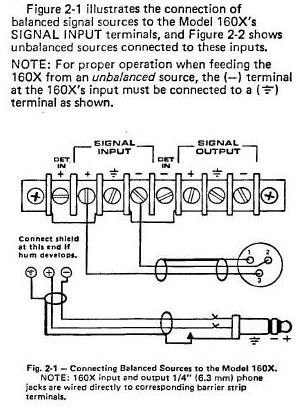
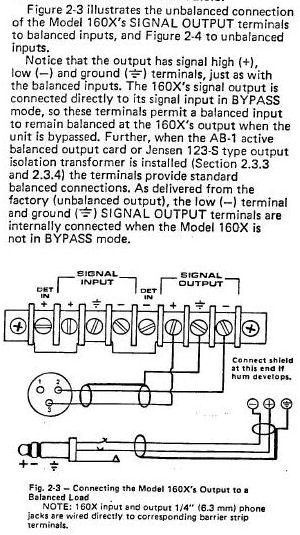

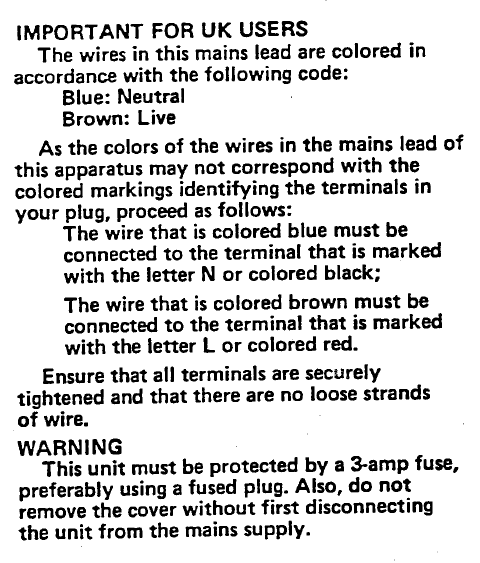
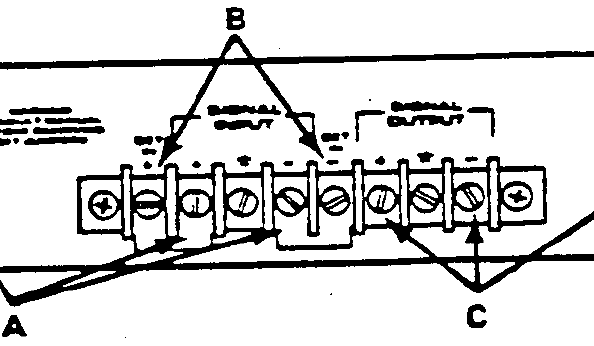



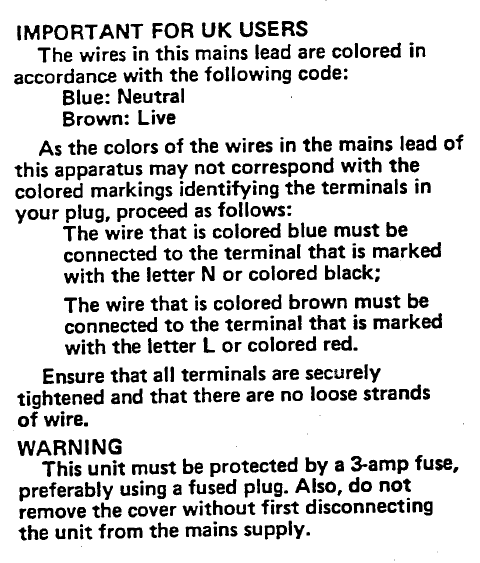
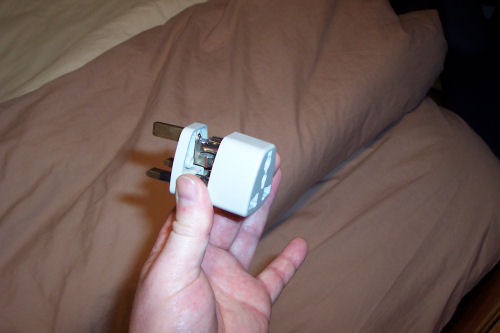
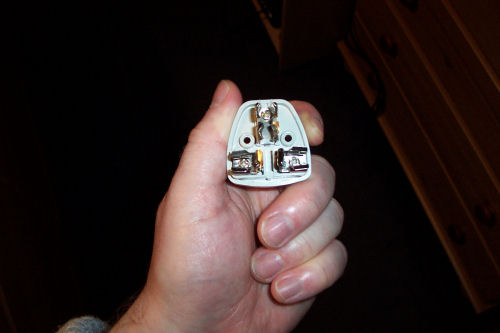

LiD, If it was a true ground problem it would usually be indepe
LiD,
If it was a true ground problem it would usually be independent of the gain and bypass. More gain would certainly amplify the hum, but it still exists at low volumes. If you're saying there is no hum at all below zero and when bypassed, I'd be suspicious of something else.
If you're connecting via the terminal strip, go ahead and try lifting the ground on the dbx terminals one at a time - first the output, then the input. You have nothing to lose by trying it. Each cable really only needs to be grounded on one end to provide a path for cable noise to drain.
If you want to try the other method, you'll need to open the XLR male and clip or de-solder the ground wire connected to pin [#1]. It's almost always a braided bare wire.
But as I indicated, I'm not convinced it is a ground problem per se.
Is the "US 'Type A' two prong" power plug polarized? - Is one blade wider than the other? Can you rotate the plug and try plugging it into your step-down converter the other way and observe what, if any, changes you hear?
I don't think I've ever seen a dbx 160x that didn't have a switch on the back [F] for European voltages. (mine do) Most are certainly capable of running at Euro voltage and Hz.
If flipping the polarity and unhooking the ground from the dbx terminals don't make any improvement, I'm afraid you may need a repairman.
They are a great compressor and nearly bullet-proof. I'll check back and see what you report.
Good luck getting it going.